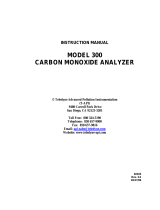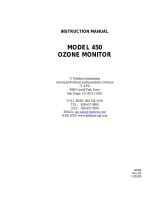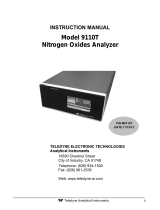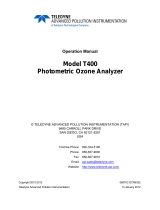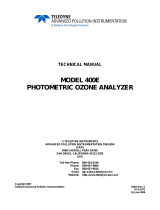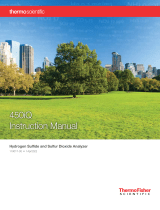Page is loading ...

OPERATION MANUAL
MODEL T101
UV FLUORESCENCE H
2
S ANALYZER
Also supports operation of:
Model T102 Analyzer
(when used in conjunction with T102 Addendum, PN 07267)
© TELEDYNE ADVANCED POLLUTION INSTRUMENTATION
9480 CARROLL PARK DRIVE
SAN DIEGO, CA 92121-5201
USA
Toll-free Phone:
800-324-5190
Phone:
858-657-9800
Fax:
858-657-9816
Email:
api-sales@teledyne.com
Website:
http://www.teledyne-api.com/
Copyright 2011 - 2012 07266B DCN6845
Teledyne Advanced Pollution Instrumentation 08 June 2012


i
ABOUT TELEDYNE ADVANCED POLLUTION INSTRUMENTATION (TAPI)
Teledyne Advanced Pollution Instrumentation (TAPI), a business unit of
Teledyne Instruments, Inc., is a worldwide market leader in the design and
manufacture of precision analytical instrumentation used for air quality
monitoring, continuous emissions monitoring, and specialty process monitoring
applications. Founded in San Diego, California, in 1988, TAPI introduced a
complete line of Air Quality Monitoring (AQM) instrumentation, which comply
with the United States Environmental Protection Administration (EPA) and
international requirements for the measurement of criteria pollutants, including
CO, SO
2
, NOx and Ozone.
Since 1988 TAPI has combined state-of-the-art technology, proven measuring
principles, stringent quality assurance systems and world class after-sales support
to deliver the best products and customer satisfaction in the business.
For further information on our company, our complete range of products, and the
applications that they serve, please visit www.teledyne-api.com or contact
NOTICE OF COPYRIGHT
© 2011-2012 Teledyne Advanced Pollution Instrumentation. All rights reserved.
TRADEMARKS
All trademarks, registered trademarks, brand names or product names appearing
in this document are the property of their respective owners and are used herein
for identification purposes only.
07266B DCN6485

ii
This page intentionally left blank.
07266B DCN6485

iii
SAFETY MESSAGES
Important safety messages are provided throughout this manual for the purpose of
avoiding personal injury or instrument damage. Please read these messages
carefully. Each safety message is associated with a safety alert symbol, and are
placed throughout this manual; the safety symbols are also located inside the
instrument. It is imperative that you pay close attention to these messages, the
descriptions of which are as follows:
WARNING: Electrical Shock Hazard
HAZARD: Strong oxidizer
GENERAL WARNING/CAUTION: Read the accompanying
message for specific information.
CAUTION: Hot Surface Warning
Do Not Touch: Touching some parts of the instrument
without protection or proper tools could result in damage to the
part(s) and/or the instrument.
Technician Symbol: All operations marked with this symbol
are to be performed by qualified maintenance personnel only.
Electrical Ground: This symbol inside the instrument marks
the central safety grounding point for the instrument.
CAUTION
This instrument should only be used for the purpose and in the
manner described in this manual. If you use this instrument in a
manner other than that for which it was intended, unpredictable
behavior could ensue with possible hazardous consequences.
NEVER use any gas analyzer to sample combustible gas(es)!
Note
For Technical Assistance regarding the use and maintenance of this instrument or any other
Teledyne API product, contact Teledyne API’s Technical Support Department:
Telephone: 800-324-5190
Email: sda_techsupport@teledyne.com
or access any of the service options on our website at http://www.teledyne-api.com/
07266B DCN6485

iv
CONSIGNES DE SÉCURITÉ
Des consignes de sécurité importantes sont fournies tout au long du présent
manuel dans le but d’éviter des blessures corporelles ou d’endommager les
instruments. Veuillez lire attentivement ces consignes. Chaque consigne de
sécurité est représentée par un pictogramme d’alerte de sécurité; ces
pictogrammes se retrouvent dans ce manuel et à l’intérieur des instruments. Les
symboles correspondent aux consignes suivantes :
AVERTISSEMENT : Risque de choc électrique
DANGER : Oxydant puissant
AVERTISSEMENT GÉNÉRAL / MISE EN GARDE : Lire la consigne
complémentaire pour des renseignements spécifiques
MISE EN GARDE : Surface chaude
Ne pas toucher : Toucher à certaines parties de l’instrument sans
protection ou sans les outils appropriés pourrait entraîner des
dommages aux pièces ou à l’instrument.
Pictogramme « technicien » : Toutes les opérations portant ce
symbole doivent être effectuées uniquement par du personnel de
maintenance qualifié.
Mise à la terre : Ce symbole à l’intérieur de l’instrument détermine le
point central de la mise à la terre sécuritaire de l’instrument.
MISE EN GARDE
Cet instrument doit être utilisé aux fins décrites et de la manière
décrite dans ce manuel. Si vous utilisez cet instrument d’une
autre manière que celle pour laquelle il a été prévu, l’instrument
pourrait se comporter de façon imprévisible et entraîner des
conséquences dangereuses.
NE JAMAIS utiliser un analyseur de gaz pour échantillonner des
gaz combustibles!
07266B DCN6485

v
WARRANTY
WARRANTY POLICY (02024 F)
Teledyne Advanced Pollution Instrumentation (TAPI), a business unit of Teledyne
Instruments, Inc., provides that:
Prior to shipment, TAPI equipment is thoroughly inspected and tested. Should
equipment failure occur, TAPI assures its customers that prompt service and support
will be available.
COVERAGE
After the warranty period and throughout the equipment lifetime, TAPI stands ready
to provide on-site or in-plant service at reasonable rates similar to those of other
manufacturers in the industry. All maintenance and the first level of field
troubleshooting are to be performed by the customer.
NON-TAPI MANUFACTURED EQUIPMENT
Equipment provided but not manufactured by TAPI is warranted and will be repaired
to the extent and according to the current terms and conditions of the respective
equipment manufacturer’s warranty.
Product Return
All units or components returned to Teledyne API should be properly packed for
handling and returned freight prepaid to the nearest designated Service Center.
After the repair, the equipment will be returned, freight prepaid.
The complete Terms and Conditions of Sale can be reviewed at
http://www.teledyne-api.com/terms_and_conditions.asp
CAUTION – Avoid Warranty Invalidation
Failure to comply with proper anti-Electro-Static Discharge (ESD) handling and packing
instructions and Return Merchandise Authorization (RMA) procedures when returning
parts for repair or calibration may void your warranty. For anti-ESD handling and
packing instructions please refer to “Packing Components for Return to Teledyne API”
in the Primer on Electro-Static Discharge section of this manual, and for RMA
procedures please refer to our Website at http://www.teledyne-api.com
under
Customer Support > Return Authorization.
07266B DCN6485

vi
This page intentionally left blank.
07266B DCN6485

vii
ABOUT THIS MANUAL
This T101 operation manual, PN 07266, is comprised of multiple documents in PDF
format, as listed below.
Part No. Rev Name/Description
07266 B Model T101 Operation Manual (this manual)
05492 D Menu Trees and Software Documentation (inserted as Appendix A of this manual)
07347
1/19/2011
Spare Parts List (in Appendix B of this manual)
05494 D Repair Questionnaire (inserted as Appendix C of this manual)
Documents included in Appendix D:
03956
A
PCA, 03955, Relay Driver
04354
D
PCA, 04003, Pressure Flow Sensor Board
04181
H
PCA, 04180, PMT Preamp
04420
B
PCA, 04120, UV Detector Preamp
04693
E
PCA, 04692, UV Lamp Driver
04932
C
PCA, Thermo-Electric Cooler Board
04468
B
PCA, 04467, Analog Output Isolator
06731
B
Schem, Auxiliary IO
05803 B Schem, Gen5 Motherboard
06698 D Schem, LCD Tchscrn Interface
06882 B Schem, LVDS transmitter
NOTE
Please read this manual in its entirety before making any attempt to operate the instrument.
REVISION HISTORY
T101 Operation Manual 072660000
REV DATE DCN DESCRIPTION
B 2012 June 08 6845 Administrative updates.
A 2011 February 14 5970 Initial Release
07266B DCN6485

viii
This page intentionally left blank.
07266B DCN6485

ix
TABLE OF CONTENTS
1. INTRODUCTION ......................................................................................................................... 19
1.1. Features .............................................................................................................................. 19
1.2. Options................................................................................................................................20
2. SPECIFICATIONS AND APPROVALS............................................................................................ 23
2.1. Specifications........................................................................................................................23
2.2. Approvals and Certifications....................................................................................................24
2.2.1. Safety ...........................................................................................................................24
2.2.2. EMC ..............................................................................................................................24
2.2.3. Other Type Certifications..................................................................................................24
3. GETTING STARTED..................................................................................................................... 25
3.1. Unpacking and Initial Setup ....................................................................................................25
3.2. Instrument Layout.................................................................................................................26
3.2.1. Front Panel ....................................................................................................................26
3.2.2. Rear Panel .....................................................................................................................30
3.2.3. Internal Chassis Layout....................................................................................................32
3.3. Electrical Connections ............................................................................................................33
3.3.1. Analog Inputs (Option 64) Connections ..............................................................................33
3.3.2. Connecting the Analog Outputs .........................................................................................34
3.3.2.1. Current Loop Analog Outputs (Option 41) Setup............................................................35
3.3.3. Connecting the Status Outputs..........................................................................................36
3.3.4. Connecting the Control Inputs...........................................................................................37
3.3.5. Connecting the Communications Ports................................................................................39
3.3.5.1. Connecting the Serial Ports ........................................................................................39
3.3.5.2. Connecting to a LAN or the Internet ............................................................................39
3.3.5.3. Connecting to a Personal Computer (USB Option)..........................................................39
3.3.5.4. Connecting to a Multidrop Network (Option) .................................................................39
3.4. Pneumatic Connections ..........................................................................................................39
3.4.1.1. Connections with Internal Valve Options Installed..........................................................45
3.5. Startup, Functional Checks, and Initial Calibration ......................................................................50
3.5.1. Startup..........................................................................................................................50
3.5.2. Warm-Up.......................................................................................................................50
3.5.3. Warning Messages ..........................................................................................................50
3.5.4. Functional Check.............................................................................................................52
3.6. Initial Calibration...................................................................................................................53
3.6.1. Basic Calibration Procedure .............................................................................................. 53
3.6.2. Interferences for H
2
S Measurements..................................................................................56
4. OPERATING INSTRUCTIONS ...................................................................................................... 57
4.1. Overview of Operating Modes..................................................................................................57
4.2. Sample Mode........................................................................................................................58
4.2.1. Test Functions ................................................................................................................58
4.2.2. Warning Messages ..........................................................................................................61
4.3. Calibration Mode ...................................................................................................................62
4.3.1. Calibration Password Security ...........................................................................................62
4.4. Setup Mode ..........................................................................................................................64
4.4.1. Setup – CFG: Viewing the Analyzer’s Configuration Information .............................................65
4.4.2. Setup – ACAL: Auto Calibration.........................................................................................66
07266B DCN6485

TABLE OF CONTENTS Teledyne API – T101 Operation Manual
x
4.4.3. Setup – DAS: Data Acquisition ..........................................................................................66
4.4.4. Setup – Range: Analog Output Reporting Range Configuration...............................................66
4.4.4.1. Available Analog Output Signals..................................................................................66
4.4.4.2. Physical Range versus Analog Output Reporting Ranges .................................................67
4.4.4.3. Reporting Range Modes .............................................................................................68
4.4.4.4. Single Range Mode (SNGL) ........................................................................................69
4.4.4.5. Independent Range Mode (IND)..................................................................................70
4.4.4.6. Auto Range Mode (AUTO) ..........................................................................................71
4.4.4.7. Range Units .............................................................................................................72
4.4.4.8. Dilution Ratio ........................................................................................................... 73
4.4.5. Setup – Pass: Password Protection ....................................................................................74
4.4.6. SETUP – CLK: Setting the Internal Time-of-Day Clock ..........................................................75
4.5. SETUP – VARS: Using the Internal Variables..............................................................................77
4.5.1. Setting the Gas Measurement Mode...................................................................................80
4.6. SETUP – DIAG: Using the Diagnostics Functions.........................................................................81
4.6.1. Signal I/O ...................................................................................................................... 83
4.6.2. Analog Output Step Test ..................................................................................................84
4.6.3. Analog I/O Configuration..................................................................................................85
4.6.3.1. Analog Output Signal Type and Range Span Selection ....................................................87
4.6.3.2. Analog Output Calibration Mode..................................................................................88
4.6.3.3. Manual Analog Output Calibration and Voltage Adjustment .............................................90
4.6.3.4. Analog Output Offset Adjustment ................................................................................92
4.6.3.5. Current Loop Output Adjustment.................................................................................92
4.6.3.6. AIN Calibration.........................................................................................................95
4.6.3.7. Analog Inputs (XIN1…XIN8) Option Configuration..........................................................96
4.6.4. Optic Test ......................................................................................................................97
4.6.5. Electrical Test.................................................................................................................98
4.6.6. Lamp Calibration............................................................................................................. 99
4.6.7. Pressure Calibration ...................................................................................................... 100
4.6.8. Flow Calibration ............................................................................................................ 101
4.6.9. Test Channel Output...................................................................................................... 102
4.7. SETUP – COMM: Setting Up the Analyser’s Communication Ports................................................ 103
4.7.1. Instrument ID .............................................................................................................. 103
4.7.2. COM Port Default Settings .............................................................................................. 105
4.7.3. RS-232 COM Port Cable Connections................................................................................ 105
4.7.4. RS-485 Configuration .................................................................................................... 107
4.7.5. DTE and DCE Communication ......................................................................................... 107
4.7.6. Ethernet Configuration................................................................................................... 107
4.7.6.1. Configuring the Ethernet Interface Using DHCP ........................................................... 107
4.7.6.2. Manually Configuring the Ethernet with Static IP Addresses .......................................... 109
4.7.6.3. Changing the Analyzer’s HOSTNAME.......................................................................... 112
4.7.7. USB Configuration......................................................................................................... 114
4.7.8. Multidrop RS-232 Set Up................................................................................................ 116
4.7.9. MODBUS Set Up ........................................................................................................... 119
4.7.10. COM Port Communication Modes ................................................................................... 121
4.7.11. COM Port Baud Rate .................................................................................................... 123
4.7.12. COM Port Testing ........................................................................................................ 124
4.8. Using the Data Acquisition System (DAS )............................................................................... 124
4.8.1. DAS Structure .............................................................................................................. 125
4.8.1.1. DAS Channels ........................................................................................................ 125
4.8.1.2. DAS Parameters ..................................................................................................... 126
4.8.1.3. DAS Configuration Limits ......................................................................................... 127
4.8.1.4. DAS Triggering Events............................................................................................. 127
4.8.2. Default DAS Channels.................................................................................................... 128
4.8.2.1. Viewing DAS Data and Settings................................................................................. 130
4.8.2.2. Editing DAS Data Channels ...................................................................................... 131
4.8.2.3. Trigger Events........................................................................................................ 133
4.8.2.4. Editing DAS Parameters........................................................................................... 134
4.8.2.5. Sample Period and Report Period .............................................................................. 135
4.8.2.6. Number of Records ................................................................................................. 137
4.8.2.7. RS-232 Report Function........................................................................................... 139
4.8.2.8. Compact Report ..................................................................................................... 139
07266B DCN6485

Teledyne API – T101 Operation Manual TABLE OF CONTENTS
xi
4.8.2.9. Starting Date ......................................................................................................... 139
4.8.2.10. Disabling/Enabling Data Channels ........................................................................... 140
4.8.2.11. HOLDOFF Feature ................................................................................................. 141
4.8.3. Remote DAS Configuration ............................................................................................. 142
5. REMOTE OPERATION................................................................................................................ 143
5.1.1. Remote Operation Using the External Digital I/O................................................................ 143
5.1.1.1. Status Outputs ....................................................................................................... 143
5.1.1.2. Control Inputs........................................................................................................ 145
5.1.2. Remote Operation Using the External Serial I/O................................................................. 146
5.1.2.1. Terminal Operating Modes ....................................................................................... 146
5.1.2.2. Help Commands in Terminal Mode............................................................................. 147
5.1.2.3. Command Syntax ................................................................................................... 148
5.1.2.4. Data Types ............................................................................................................ 148
5.1.2.5. Status Reporting..................................................................................................... 149
5.1.2.6. General Message Format.......................................................................................... 150
5.1.2.7. Remote Access by Modem........................................................................................ 150
5.1.2.8. COM Port Password Security..................................................................................... 153
5.1.2.9. APICOM Remote Control Program.............................................................................. 153
5.1.3. Additional Communications Documentation....................................................................... 154
5.1.4. Using the T101 with a Hessen Protocol Network................................................................. 155
5.1.4.1. General Overview of Hessen Protocol......................................................................... 155
5.1.4.2. Hessen COMM Port Configuration .............................................................................. 155
5.1.4.3. Activating Hessen Protocol ....................................................................................... 156
5.1.4.4. Selecting a Hessen Protocol Type .............................................................................. 157
5.1.4.5. Setting The Hessen Protocol Response Mode............................................................... 157
5.1.4.6. Hessen Protocol Gas ID ........................................................................................... 159
5.1.4.7. Setting Hessen Protocol Status Flags ......................................................................... 160
6. CALIBRATION PROCEDURES.................................................................................................... 163
6.1. Calibration Preparations ....................................................................................................... 163
6.1.1. Required Equipment, Supplies, and Expendables ............................................................... 163
6.1.2. Zero Air....................................................................................................................... 164
6.1.3. Gas Standards.............................................................................................................. 164
6.1.4. Permeation Tubes ......................................................................................................... 164
6.1.5. Calibration Gas Traceability ............................................................................................ 165
6.1.6. Data Recording Devices ................................................................................................. 165
6.2. Manual Calibration............................................................................................................... 165
6.3. Manual Calibration Checks .................................................................................................... 169
6.4. Manual Calibration with Zero/Span Valves............................................................................... 170
6.5. Manual Calibration with IZS Option ........................................................................................ 173
6.6. Manual Calibration Checks with IZS or Zero/Span Valves .......................................................... 174
6.7. Manual Calibration in INDEPENDENT or AUTO Reporting Range Modes......................................... 177
6.7.1. Calibration With Remote Contact Closures ........................................................................ 177
6.8. Manual Calibration in Multigas Measurement Mode ................................................................... 178
6.9. Automatic Calibration/Checks (AutoCal).................................................................................. 179
6.9.1. Autocal of Instruments in INDEPENDENT or AUTO Reporting Range Modes ............................ 183
6.9.2. Autocal of Instruments in Multigas Measurement Mode ....................................................... 184
6.10. Calibration Quality ............................................................................................................. 185
7. EPA PROTOCOL CALIBRATION ................................................................................................. 187
7.1. Calibration Requirements...................................................................................................... 187
7.1.1. Calibration of Equipment ................................................................................................ 187
7.1.2. Data Recording Device................................................................................................... 189
7.1.3. Recommended Standards for Establishing Traceability ........................................................ 189
7.1.4. EPA Calibration Using Permeation Tubes........................................................................... 189
7.1.5. Calibration Frequency .................................................................................................... 190
7.1.6. Record Keeping ............................................................................................................ 190
7.1.7. Summary of Quality Assurance Checks............................................................................. 191
7.2. Level 1 Calibrations versus Level 2 Checks .............................................................................. 191
7.3. ZERO and SPAN Checks........................................................................................................ 193
7.3.1. Zero/Span Check Procedures .......................................................................................... 193
7.4. Precisions Calibration Procedures and Checks .......................................................................... 193
7.4.1. Precision Calibration ...................................................................................................... 194
7.4.2. Precision Check............................................................................................................. 194
07266B DCN6485

TABLE OF CONTENTS Teledyne API – T101 Operation Manual
xii
7.5. Dynamic Multipoint Span Calibration ...................................................................................... 195
7.6. Special Calibration Requirements for Independent Range or Auto Range...................................... 196
7.7. References ......................................................................................................................... 196
8. INSTRUMENT MAINTENANCE................................................................................................... 197
8.1. Maintenance Schedule.......................................................................................................... 197
8.2. Predictive Diagnostics .......................................................................................................... 201
8.3. Maintenance Procedures ....................................................................................................... 202
8.3.1. Changing the Sample Particulate Filter ............................................................................. 202
8.3.2. Changing the IZS Permeation Tube.................................................................................. 203
8.3.3. Maintaining the SO
2
Scrubber ......................................................................................... 203
8.3.3.1. Predicting When the SO
2
Scrubber Should Be Replaced. ............................................... 203
8.3.3.2. Checking the Function of the SO
2
Scrubber................................................................. 204
8.3.3.3. Changing the SO
2
Scrubber Material .......................................................................... 204
8.3.4. Changing the External Zero Air Scrubber .......................................................................... 205
8.3.5. Maintaining the H
2
S SO
2
Converter .............................................................................. 206
8.3.5.1. Predicting When the Converter Catalyst Should Be Replaced. ........................................ 206
8.3.5.2. Checking the Efficiency of the H
2
S SO
2
Converter..................................................... 206
8.3.5.3. Changing the H
2
S SO
2
Converter Catalyst Material ................................................... 207
8.3.6. Checking for Light Leaks ................................................................................................ 209
8.3.7. Changing the Critical Flow Orifice .................................................................................... 209
9. TROUBLESHOOTING & SERVICE............................................................................................... 211
9.1. General Troubleshooting....................................................................................................... 211
9.1.1. Fault Diagnosis with Warning Messages............................................................................ 212
9.1.2. Fault Diagnosis with Test Functions.................................................................................. 216
9.1.3. Using the Diagnostic Signal I/O Function .......................................................................... 217
9.1.4. Status LEDs ................................................................................................................. 218
9.1.4.1. Motherboard Status Indicator (Watchdog) .................................................................. 219
9.1.4.2. CPU Status Indicator ............................................................................................... 219
9.1.4.3. Relay Board Status LEDs.......................................................................................... 219
9.2. Gas Flow Problems .............................................................................................................. 220
9.2.1. Zero or Low Sample Flow ............................................................................................... 221
9.2.2. High Flow..................................................................................................................... 221
9.3. Calibration Problems ............................................................................................................ 221
9.3.1. Negative Concentrations ................................................................................................ 221
9.3.2. No Response ................................................................................................................ 222
9.3.3. Unstable Zero and Span................................................................................................. 222
9.3.4. Inability to Span - No SPAN Button.................................................................................. 222
9.3.5. Inability to Zero - No ZERO Button .................................................................................. 223
9.3.6. Non-Linear Response..................................................................................................... 223
9.3.7. Discrepancy Between Analog Output and Display ............................................................... 224
9.4. Other Performance Problems................................................................................................. 224
9.4.1. Excessive Noise ............................................................................................................ 224
9.4.2. Slow Response ............................................................................................................. 224
9.4.3. The Analyzer Doesn’t Appear on the LAN or Internet .......................................................... 225
9.5. Subsystem Checkout ........................................................................................................... 225
9.5.1. Detailed Pressure Leak Check ......................................................................................... 225
9.5.2. Performing a Sample Flow Check..................................................................................... 226
9.5.3. AC Power Configuration ................................................................................................. 226
9.5.4. DC Power Supply .......................................................................................................... 227
9.5.5. I
2
C Bus........................................................................................................................ 228
9.5.6. Touchscreen Interface ................................................................................................... 228
9.5.7. LCD Display Module....................................................................................................... 228
9.5.8. Relay Board ................................................................................................................. 228
9.5.9. Motherboard................................................................................................................. 229
9.5.9.1. A/D functions......................................................................................................... 229
9.5.9.2. Analog Output Voltages ........................................................................................... 229
9.5.9.3. Status Outputs ....................................................................................................... 230
9.5.9.4. Control Inputs........................................................................................................ 230
9.5.10. CPU........................................................................................................................... 230
9.5.11. RS-232 Communication................................................................................................ 231
9.5.11.1. General RS-232 Troubleshooting ............................................................................. 231
9.5.11.2. Modem or Terminal Operation................................................................................. 231
07266B DCN6485

Teledyne API – T101 Operation Manual TABLE OF CONTENTS
xiii
9.5.12. PMT Sensor ................................................................................................................ 232
9.5.13. PMT Preamplifier Board ................................................................................................ 232
9.5.14. PMT Temperature Control PCA....................................................................................... 232
9.5.15. High Voltage Power Supply ........................................................................................... 233
9.5.16. Pneumatic Sensor Assembly.......................................................................................... 233
9.5.16.1. Sample Pressure................................................................................................... 233
9.5.17. IZS Option ................................................................................................................. 233
9.5.18. Box Temperature ........................................................................................................ 234
9.5.19. PMT Temperature ........................................................................................................ 234
9.6. Repair Procedures ............................................................................................................... 234
9.6.1. Disk-on-Module Replacement.......................................................................................... 234
9.6.2. Adjusting the UV Lamp (Peaking the Lamp) ...................................................................... 235
9.6.3. Replacing the UV Lamp .................................................................................................. 237
9.6.4. Factory Cal (PMT Sensor, Hardware Calibration) ................................................................ 238
9.7. Frequently Asked Questions (FAQs)........................................................................................ 240
9.8. Technical Assistance ............................................................................................................ 241
10. PRINCIPLES OF OPERATION.................................................................................................. 243
10.1. Measurement Principle ....................................................................................................... 243
10.1.1. H
2
S Conversion ........................................................................................................... 243
10.1.2. SO
2
Ultraviolet Fluorescence ......................................................................................... 244
10.2. The UV Light Path .............................................................................................................. 247
10.2.1. UV Source Lamp ......................................................................................................... 247
10.2.2. The Reference Detector................................................................................................ 248
10.2.3. The PMT..................................................................................................................... 248
10.2.4. Optical Filters ............................................................................................................. 249
10.2.4.1. UV Source Optical Filter ......................................................................................... 249
10.2.4.2. PMT Optical Filter.................................................................................................. 249
10.2.5. Optical Lenses ............................................................................................................ 250
10.2.6. Measurement Interferences .......................................................................................... 251
10.2.6.1. Direct Interference................................................................................................ 251
10.2.6.2. UV Absorption by Ozone ........................................................................................ 252
10.2.6.3. Dilution ............................................................................................................... 252
10.2.6.4. Third Body Quenching............................................................................................ 252
10.2.6.5. Light Pollution ...................................................................................................... 252
10.3. Pneumatic Operation .......................................................................................................... 253
10.3.1. Sample Gas Flow......................................................................................................... 254
10.3.2. Multigas Measurement & H
2
S SO
2
Switching Valve. ....................................................... 255
10.3.3. Flow Rate Control........................................................................................................ 255
10.3.3.1. Critical Flow Orifice ............................................................................................... 255
10.3.4. Sample Particulate Filter............................................................................................... 256
10.3.5. Hydrocarbon Scrubber (Kicker) ..................................................................................... 257
10.3.6. SO
2
Scrubber.............................................................................................................. 257
10.3.7. Pneumatic Sensors ...................................................................................................... 258
10.3.7.1. Sample Pressure Sensor ........................................................................................ 258
10.3.7.2. Sample Flow Sensor .............................................................................................. 258
10.4. Electronic Operation........................................................................................................... 259
10.4.1. CPU........................................................................................................................... 261
10.4.1.1. Disk On Module (DOM) .......................................................................................... 261
10.4.1.2. Flash Chip............................................................................................................ 261
10.4.2. Sensor Module & Sample chamber ................................................................................. 262
10.4.3. Sample Chamber Heating Circuit ................................................................................... 262
10.4.4. Photo Multiplier Tube (PMT) .......................................................................................... 263
10.4.5. PMT Cooling System .................................................................................................... 264
10.4.5.1. Thermoelectric Cooler (TEC) ................................................................................... 264
10.4.5.2. TEC Control Board................................................................................................. 265
10.4.6. PMT Preamplifier ......................................................................................................... 265
10.4.7. Pneumatic Sensor Board............................................................................................... 267
10.4.8. Relay Board................................................................................................................ 267
10.4.8.1. Heater Control...................................................................................................... 267
10.4.8.2. Valve Control ....................................................................................................... 267
10.4.9. Status LEDs & Watch Dog Circuitry ................................................................................ 268
10.4.10. Motherboard ............................................................................................................. 269
07266B DCN6485

TABLE OF CONTENTS Teledyne API – T101 Operation Manual
xiv
10.4.10.1. A to D Conversion ............................................................................................... 269
10.4.10.2. Sensor Inputs..................................................................................................... 269
10.4.10.3. Thermistor Interface............................................................................................ 270
10.4.11. Analog Outputs ......................................................................................................... 270
10.4.12. External Digital I/O.................................................................................................... 271
10.4.13. I
2
C Data Bus............................................................................................................. 271
10.4.14. Power up Circuit ........................................................................................................ 271
10.5. Power Supply/ Circuit Breaker ............................................................................................. 271
10.6. Front Panel/Display Interface .............................................................................................. 273
10.6.1. LVDS Transmitter Board ............................................................................................... 273
10.6.2. Front Panel Interface PCA ............................................................................................. 273
10.7. Software Operation ............................................................................................................ 274
10.7.1. Adaptive Filter ............................................................................................................ 274
10.7.2. Calibration - Slope and Offset........................................................................................ 275
10.7.3. Temperature and Pressure Compensation (TPC) Feature ................................................... 276
10.7.4. Internal Data Acquisition System (DAS )......................................................................... 276
11. A PRIMER ON ELECTRO-STATIC DISCHARGE.......................................................................... 277
11.1. How Static Charges are Created........................................................................................... 277
11.2. How Electro-Static Charges Cause Damage ........................................................................... 278
11.3. Common Myths About ESD Damage ..................................................................................... 279
11.4. Basic Principles of Static Control .......................................................................................... 280
11.4.1. General Rules ............................................................................................................. 280
11.4.2. Basic anti-ESD Procedures for Analyzer Repair and Maintenance ........................................ 282
11.4.2.1. Working at the Instrument Rack.............................................................................. 282
11.4.2.2. Working at an Anti-ESD Work Bench........................................................................ 282
11.4.2.3. Transferring Components from Rack to Bench and Back.............................................. 283
11.4.2.4. Opening Shipments from Teledyne API..................................................................... 283
11.4.2.5. Packing Components for Return to Teledyne API........................................................ 284
LIST OF APPENDICES
APPENDIX A - VERSION SPECIFIC SOFTWARE DOCUMENTATION
APPENDIX B - T101 SPARE PARTS LIST
APPENDIX C - REPAIR QUESTIONNAIRE - T101
APPENDIX D - ELECTRONIC SCHEMATICS
07266B DCN6485

Teledyne API – T101 Operation Manual TABLE OF CONTENTS
xv
LIST OF FIGURES
Figure 3-1. Front Panel Layout ........................................................................................... 27
Figure 3-2. Display Screen and Touch Control ...................................................................... 27
Figure 3-3. Display/Touch Control Screen Mapped to Menu Charts.......................................... 29
Figure 3-4. Rear Panel Layout............................................................................................ 30
Figure 3-5. Internal Chassis Layout..................................................................................... 32
Figure 3-6. Analog In Connector......................................................................................... 33
Figure 3-7. Analog Output Connector .................................................................................. 34
Figure 3-8. Current Loop Option Installed on the Motherboard ................................................ 35
Figure 3-9. Status Output Connector................................................................................... 36
Figure 3-10. Control Input Connector .................................................................................. 38
Figure 3-11. Pneumatic Connections, Basic Configuration Using Gas Dilution Calibrator .............. 40
Figure 3-12. Pneumatic Connections, Basic Configuration Using Bottled Span Gas ..................... 41
Figure 3-13. Pneumatic Diagram of the T101 Standard Configuration ...................................... 42
Figure 3-14. Basic Pneumatic Connections for Units with Valve Options.................................... 45
Figure 3-15. Pneumatic Diagram of the T101 With Z/S Option Installed ................................... 46
Figure 3-16. Pneumatic Diagram of the T101 with IZS Options Installed................................... 49
Figure 4-1. Viewing T101 TEST Functions ............................................................................ 60
Figure 4-2. Viewing and Clearing T101 WARNING Messages ................................................... 62
Figure 4-3. Analog Output Connectors Defined ..................................................................... 66
Figure 4-4. Setup for Calibrating Analog Outputs .................................................................. 91
Figure 4-5. Setup for Calibrating Current Outputs ................................................................. 93
Figure 4-6. DIAG – Analog Inputs (Option) Configuration Menu............................................... 96
Figure 4-7. Rear Panel Connector Pin-Outs for RS-232 Mode ................................................ 105
Figure 4-8. CPU Connector Pin-Outs for RS-232 Mode ......................................................... 106
Figure 4-9. Jumper and Cables for Multidrop Mode.............................................................. 117
Figure 4-10.Multidrop PCA Host/Analyzer Interconnect Diagram............................................ 118
Figure 4-11. Default DAS Channels Setup .......................................................................... 129
Figure 4-12. APICOM User Interface for Configuring the DAS................................................ 142
Figure 5-1. Status Output Connector................................................................................. 144
Figure 5-2. Control Inputs with Local 5 V Power Supply ....................................................... 146
Figure 5-3.Control Inputs with External 5 V Power Supply .................................................... 146
Figure 5-4. APICOM Remote Control Program Interface ....................................................... 154
Figure 6-1. Setup for Manual Calibration without Z/S Valve or IZS Option .............................. 166
Figure 6-2. Setup for Manual Calibration with Z/S Valve Option Installed................................ 170
Figure 6-3. Setup for Manual Calibration Check with Z/S Valve or IZS Option.......................... 175
Figure 6-4. Typical Setup for Manual Calibratio in Multigas Measurement Mode ....................... 178
Figure 8-1. Sample Particulate Filter Assembly ................................................................... 202
Figure 8-2. Charcoal Canister Assembly............................................................................. 205
Figure 8-3. H2S - SO2 Converter Assembly........................................................................ 208
Figure 8-4. Critical Flow Orifice Assembly ......................................................................... 210
Figure 9-1. Viewing and Clearing Warning Messages ........................................................... 214
Figure 9-2. Example of Signal I/O Function ........................................................................ 218
Figure 9-3. CPU Status Indicator ...................................................................................... 219
Figure 9-4. Shutter Assembly........................................................................................... 236
Figure 9-5. Location of UV Reference Detector Potentiometer ............................................... 237
Figure 9-6. Pre-Amplifier Board Layout.............................................................................. 239
Figure 10-1. UV Absorption.............................................................................................. 245
Figure 10-2. UV Light Path .............................................................................................. 247
Figure 10-3. Source UV Lamp Construction ........................................................................ 248
Figure 10-4. Excitation Lamp UV Spectrum Before/After Filtration ......................................... 249
Figure 10-5. PMT Optical Filter Bandwidth.......................................................................... 250
Figure 10-6. Effects of Focusing Source UV in Sample Chamber ............................................ 250
Figure 10-7. T101 Gas Flow and Location of Critical Flow Orifice ........................................... 254
07266B DCN6485

TABLE OF CONTENTS Teledyne API – T101 Operation Manual
xvi
Figure 10-8. Typical Flow Control Assembly with Critical Flow Orifice ..................................... 256
Figure 10-9. T101 Hydrocarbon Scrubber (Kicker) .............................................................. 257
Figure 10-10. T101 Electronic Block Diagram ..................................................................... 259
Figure 10-11. T101 CPU Board ......................................................................................... 261
Figure 10-12. T101 Sample Chamber................................................................................ 262
Figure 10-13. PMT Assembly............................................................................................ 263
Figure 10-14. Basic PMT Design ....................................................................................... 264
Figure 10-15. PMT Cooling System ................................................................................... 265
Figure 10-16. PMT Preamp Block Diagram ......................................................................... 266
Figure 10-17. Relay Board Status LED Locations ................................................................. 268
Figure 10-18. Power Distribution Block Diagram ................................................................. 272
Figure 10-19. Front Panel and Display Interface Block Diagram............................................. 273
Figure 10-20. Basic Software Operation............................................................................. 274
Figure 11-1. Triboelectric Charging ................................................................................... 277
Figure 11-2. Basic anti-ESD Work Station .......................................................................... 280
LIST OF TABLES
Table 1-1. Analyzer Options............................................................................................... 20
Table 2-1. Model T101 Basic Unit Specifications.................................................................... 23
Table 3-1. Display Screen and Touch Control Description ....................................................... 28
Table 3-2. Rear Panel Description ....................................................................................... 31
Table 3-3. Analog Input Pin Assignments............................................................................. 34
Table 3-4. Analog Output Pin Assignmentss ......................................................................... 35
Table 3-5. Status Output Signals........................................................................................ 37
Table 3-6. Control Input Signals......................................................................................... 38
Table 3-7. Inlet / Outlet Connector Descriptions ................................................................... 40
Table 3-8. H
2
S – SO
2
Switching Valve Operating States ......................................................... 42
Table 3-9. NIST-SRM's Available for Traceability of H
2
S & SO
2
Calibration Gases ....................... 44
Table 3-10. Zero/Span Valve Operating States ..................................................................... 46
Table 3-11. IZS Valve Operating States............................................................................... 49
Table 3-12. Possible Warning Messages at Start-Up .............................................................. 51
Table 4-1. Analyzer Operating Modes .................................................................................. 57
Table 4-2. Test Functions Defined....................................................................................... 59
Table 4-3. List of Warning Messages ................................................................................... 61
Table 4-4. Primary Setup Mode Features and Functions ......................................................... 64
Table 4-5. Secondary Setup Mode Features and Functions ..................................................... 64
Table 4-6. Password Levels............................................................................................... 74
Table 4-7. Variable Names (VARS)...................................................................................... 77
Table 4-8. T101 Diagnostic (DIAG) Functions ....................................................................... 81
Table 4-9. DIAG - Analog I/O Functions............................................................................... 85
Table 4-10. Analog Output Voltage Ranges .......................................................................... 85
Table 4-11. Analog Output Current Loop Range .................................................................... 86
Table 4-12. Analog Output Pin Assignments ......................................................................... 86
Table 4-13. Voltage Tolerances for Analog Output Calibration ................................................. 90
07266B DCN6485

Teledyne API – T101 Operation Manual TABLE OF CONTENTS
xvii
Table 4-14. Current Loop Output Calibration with Resistor ..................................................... 94
Table 4-15. Test Parameters Available for Analog Output A4 ................................................ 102
Table 4-16. Ethernet Status Indicators .............................................................................. 107
Table 4-17. LAN/Internet Default Configuration Properties ................................................... 109
Table 4-18. Internet Configuration Touchscreen Button Functions ......................................... 113
Table 4-19. COMM Port Communication Modes ................................................................... 121
Table 4-20. Front Panel LED Status Indicators for DAS ........................................................ 125
Table 4-21. DAS Data Channel Properties .......................................................................... 126
Table 4-22. DAS Data Parameter Functions........................................................................ 127
Table 5-1. Status Output Pin Assignments ......................................................................... 145
Table 5-2. Control Input Pin Assignments .......................................................................... 145
Table 5-3. Terminal Mode Software Commands .................................................................. 147
Table 5-4. Command Types ............................................................................................. 148
Table 5-5. Serial Interface Documents .............................................................................. 154
Table 5-6. Hessen RS-232 Communication Parameters ........................................................ 155
Table 5-7. T101 Hessen Protocol Response Modes............................................................... 157
Table 5-8. Default Hessen Status Bit Assignments .............................................................. 160
Table 6-1. NIST-SRM's Available for Traceability of H2S and SO2 Calibration Gases ................. 165
Table 6-2. AutoCal Modes................................................................................................ 179
Table 6-3. AutoCal Attribute Setup Parameters................................................................... 180
Table 6-4. Example Auto-Cal Sequence ............................................................................. 181
Table 6-5. Example Auto-Cal Sequence ............................................................................. 185
Table 7-1. Activity Matrix for Calibration Equipment & Supplies............................................. 188
Table 7-2. Activity Matrix for Calibration Procedure ............................................................. 189
Table 7-3. Activity Matrix ................................................................................................ 191
Table 7-4. Definition of Level 1 and Level 2 Zero and Span Checks........................................ 192
Table 8-1 T101 Preventive Maintenance Schedule ............................................................... 199
Table 8-2 Predictive Uses for Test Functions....................................................................... 201
Table 9-1. Warning Messages - Indicated Failures............................................................... 214
Table 9-2. Test Functions - Possible Causes for Out-Of-Range Values .................................... 216
Table 9-3. Relay Board Status LEDs .................................................................................. 220
Table 9-4. DC Power Test Point and Wiring Color Code ........................................................ 227
Table 9-5. DC Power Supply Acceptable Levels ................................................................... 227
Table 9-6. Relay Board Control Devices ............................................................................. 229
Table 9-7. Analog Output Test Function - Nominal Values .................................................... 229
Table 9-8. Status Outputs Check Pin Out ........................................................................... 230
Table 9-9. Example of UV Lamp Power Supply Outputs........................................................ 237
07266B DCN6485

TABLE OF CONTENTS Teledyne API – T101 Operation Manual
xviii
This page intentionally left blank.
07266B DCN6485
/
